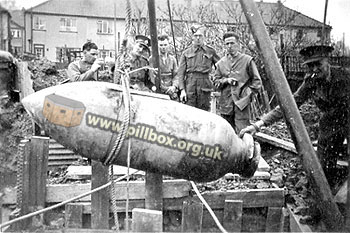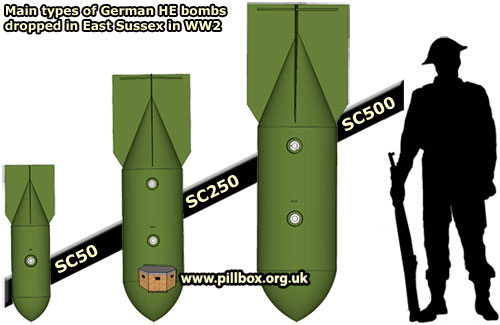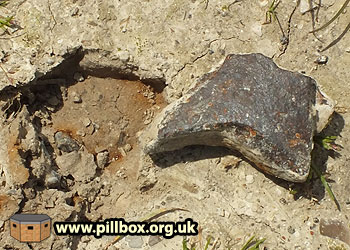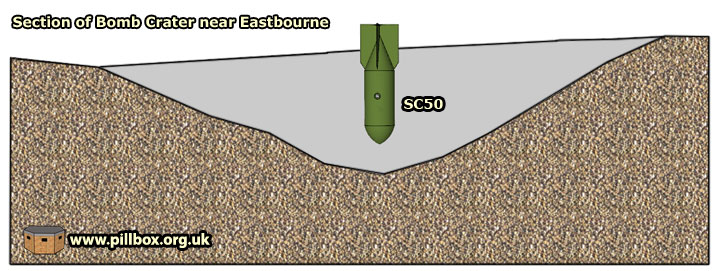Bomb craters (4) - Bomb Reconnaissance
Posted: 9 July 2012 21:55
In Part 2 and Part 3 of this series, we looked at some bomb craters near Lewes and Eastbourne. It's time we had a look at some of the German bombs that might have caused them.
We'll also see how bombs were identified by Home Office investigators and whether or not my data (gathered 70 years after the event), can possibly help identify bomb sizes.
We've already seen some basic data on crater sizes, but we need to take into account various complicating factors. I'll be comparing my crater survey findings with data from actual wartime bomb incidents in East Sussex sourced from TNA files.
In addition to the raw documents, there's quite a bit of literature available on the subject of bombs: Manual of Bomb Disposal (1941), Objects Dropped from the Air (1941, 1943 and 1944 editions) and Bomb Reconnaissance and Protection Against Unexploded Bombs (1942).

Bomb Reconnaissance
Unexploded bombs (UXBs) were an obvious hazard whenever encountered. Many were set with delayed-action fuses that might detonate the bomb up to 80 hours after it had dropped; meaning that moves to deal with such devices had to wait until 96 hours to be on the safe side.
The daily average of UXBs dropped in Great Britain (excluding RAF and Royal Naval establishments) between 21st September 1940 and 5th July 1941 was 84. Of this 84, on average, seven would be delayed-action bombs and would explode. The remaining 77 bombs were "duds", of which, on avaerage, five would be delayed-action duds.
Following an incident, bomb reconnaissance would be conducted to ascertain the danger from any UXBs. All military units were trained in this and were to report UXBs to the local Air Raid Precautions (later Civil Defence) organisation.
Craters and holes in the ground were to be carefully examined (see Part 1) and safety precautions taken pending the arrival of a Bomb Disposal (BD) team.
Bomb Disposal
Bomb disposal was originally conducted by Field Companies of the Royal Engineers, but as the task became more complex and specialist, dedicated Bomb Disposal Companies were formed to deal with unexploded ordnance.
The RAF and Royal Navy dealt with bombs in their own establishments (airfields, harbours and docks), but otherwise the RE dealt with most other areas in the UK.
The methods and techniques of bomb disposal are beyond the scope of this piece, but the UXB would be treated with respect, due to the danger of movement or German anti-handling devices setting it off.

Once identified, it would then be decided whether or not it was safe to extract the bomb from the hole it had made, and whether it was to be defused or subjected to a controlled explosion in situ.
The photo at right shows a Bomb Disposal team lifting what appears to be a 1,000kg SC1000 bomb (nicknamed Hermann by the Germans) having dug it out of its hole. The location and date of this are unknown.
In one incident in 1943, a Bomb Disposal team digging out a UXB at Fairlight had a close shave when a Focke-Wulf FW190 came in at 350 feet and promptly dropped a 500kg bomb nearby. There were no casualties, but the explosion might well have triggered the bomb they were looking for. Poor visibility meant that it was unlikely the German pilot was able to see the BD squad, the proximity of the fresh attack being seen as coincidence.
German High Explosive (HE) Bombs

The three main weights of HE bombs that are relevant to us are: 50kg, 250kg and 500kg and these came in two varieties, general purpose and armour-piercing.
The latter had thicker bomb casings to allow the bomb to penetrate concrete surfaces such as roofs and roads before detonating. These bombs were prefixed 'SD' followed by their weight, while general purpose bombs were prefixed 'SC', e.g. SD50 and SC50.
The graphic at right gives an indication of scale of the SC range of bombs:
There were also smaller anti-personnel bombs, incendiary bombs, parachute mines and larger HE bombs up to 1,800kg.
Identification of German Bombs
By 1941 the Home Office's Research and Experiments Department was extending its interest in air raid incidents beyond the main cities. Selected raids across the country were investigated with a view to assessing factors such as the number and type of bombs used, their effect on different types of buildings (particularly air raid shelters) and casualties.

Once the Bomb Disposal team had made safe any UXBs, the Research and Experiments Department boffins could begin their investigation, although they might only arrive after some of the clearing up had begun. There are some instances of bomb craters having been filled in before they could be measured for depth.
One of the first things the investigators would be looking for in the vicinity of a bomb crater would be the presence of the bomb's tail fins.
The photo at right is of the tail unit from a German SC50 bomb.
Tail fins usually parted company upon initial impact if the bomb didn't detonate immediately, but would often be blown clear by the explosion and so could be picked up and used to help identify the bomb type.
Another clue would be the presence of splinters from the bomb casing; pieces could be extracted from the blackened walls of the crater or the surrounding area.
Our manuals also tell us the following about craters:
When bombs of 1,000 Kg. or larger fall, a crater which may be as big as 10 feet in diameter and 4 feet deep may be formed. This is not due to explosion, but to the shock of impact.Similar, but smaller craters may be formed when bombs of smaller calibre wobble in flight or are deflected by hitting a building. In such cases the true size of the bomb can often be ascertained by scraping away the earth at the bottom of the crater, so as to disclose the true hole of entry.
Unless a bomb hole is examined within 24 hours of the bomb falling, it will frequently be found that the hole has crumbled or broken away at the surface and has partially filled up. In built-up areas, debris from any buildings, etc., hit by the bomb in its fall will often be found to have filled up the hole, making it impossible to determine the size of the bomb. A reliable guide as to the size is provided by the tail of the bomb whenever that can be recovered in a reasonably unmutilated condition.
But there were always difficulties in identifying a bomb. One report of a crater 11' diameter and 3'6 deep at Hastings states:
Bomb was first reported as a 1,000kg UX unexploded. After digging by bomb disposal unit fragments of bomb were found which established the bomb to be a 50kg X exploded.
Now that we have some modern fieldwork survey data, we need to look at some Home Office reports and see if we can make sense of craters and bomb sizes.
Actual Crater Data
Note: this section is numbers that you may not find very interesting - skip to conclusion if you trust my data!
| Table 1 - typical bomb data | ||
|---|---|---|
| Bomb Weight | Crater Diameter | Crater Depth |
| 50 KG | 8-12 ft (2.4 - 3.6m) | 2-5 ft (0.6 - 1.5m) |
| 100 KG | 20-30 ft (6-9.1m) | 7-10 ft (2.1-3m) |
| 250 KG | 24-36 ft (7.3-11m) | 10-12 ft (3-3.7m) |
| 500 KG | 30-40 ft (9.1-12.2m) | 10-16ft (3-4.9m) |
In the first part of this series, I reproduced the table of crater size by bomb weight seen at right.
The list of bombs includes a mysterious 100kg weapon that I've been unable to explain (possibly Italian), but this table was compiled in September 1940, when accurate data was still being collected and the study of modern air raids was in its infancy.
I'm not convinced that it is quite so easy to identify a bomb type by its crater size 70 years after the event, using fieldwork alone. The reason I say this is based on my study of the data that is more comprehensive than that in Table 1.
The data I have is also specifically related to East Sussex, collected by the Home Office following various air raid incidents, making it more accurate - and more problematic - than the generic data in Table 1.
| Table 2 - East Sussex bomb data | ||||
|---|---|---|---|---|
| Bomb | Size | Soil | Diameter | Depth |
| 33 | 50kg | Chalk | 9' | 4' |
| 34 | 50kg | Chalk | 2' | 5' |
| 35 | 50kg | Chalk | 9' | 5' |
| 36 | 50kg | Chalk | 12' | 5' |
| 37 | 50kg | Chalk | 15' | 4' |
| 38 | 50kg | Chalk | 15' | 0* |
| * Depth not recorded as crater had been filled in | ||||
At the top of Part 3 I mentioned a stick of six 50kg bombs that landed 500m away from craters 3, 4 and 5. The data from the records for these is given in the Table 2 at right.
A key point to realise is that bombs 33 and 34 (a total of 38 bombs were recorded as part of that raid) presumably fell from the same aircraft travelling at the same speed, course and altitude, yet one crater was seven feet (2m) larger than the other - but they only landed 10m apart!
Another 50kg bomb (not in Table 2) that landed 200m away as part of a different stick, left a crater just 3 x 1 ft (91 x 30cm). These bombs undermine Table 1's data in terms of diameter. Crater depth of 50kg bombs between the two tables appears to be more reliable, but the craters today will not be as deep as they were 70 years ago.
| Table 3 - Bomb craters in chalk in East Sussex | ||||
|---|---|---|---|---|
| Diameter | Depth | Soil | Bomb | A/C Altitude |
| 3'6" | 1' | chalk | 50kg | 2500 feet |
| 9' | 5' | chalk | 50kg | 2500 |
| 26' | 6' | Grassland chalk flint subsoil | 250kg | 700 |
| 30' | 10' | chalk clay | 250kg | 150 |
| 31' | 10' | Arable land chalk subsoil | 250kg | 6000 |
| 32' | 12' | Arable land chalk subsoil | 250kg | 6000 |
| 34' | 10' | Arable land chalk subsoil | 250kg | 6000 |
| 36' | 12' | Downland chalk subsoil | 250kg | 6000 |
| 12' | 5'6" | Clay chalk & stone | 500kg | 0 (A/C crashed) |
| 14' | 6' | Chalk & clay | 500kg | 200 |
| 20' | 6' | Chalky clay | 500kg | 200 |
| 35' | 7' | Light chalky soil | 500kg | 650 |
We need more data: Table 3 at right contains data across all three bomb sizes; I've only included craters in chalk, which is the geology in which all five craters lie.
Table 4 below summarizes the five craters at Lewes and Eastbourne. Dimensions in both tables are in feet and inches for easy comparison.
| Table 4 - East Sussex bomb craters | |||
|---|---|---|---|
| Crater | Diameter | Depth | Bomb? |
| 1 | 20' | 3' | 250-500kg |
| 2 | 21' | 6' | 250-500kg |
| 3 | 12' | 3' | 50kg |
| 4 | 16' | 4' | 50kg |
| 5 | 13' | 2' | 50kg |
Identifying the bomb sizes of our craters

Let's crunch the easy numbers of Table 4 first - I've speculated that craters 3-5 were caused by 50kg bombs on account of the data in Table 2 that was measured from craters only 500m away from these.
I found a splinter of metal on the surface between craters 4 and 5 (Photo right) - see Part 3 for a proper description. Its thickness matches that of the SD50 and SD250 bombs; the former certainly matches the crater size of 3,4 and 5.
Whether the fragment really is part of a German bomb is another matter however!
Otherwise, I'm reasonably satisfied that craters 3-5 are the result of 50kg bombs; the section of crater 4 from Part 3 is below with an SC50 bomb scaled in; the SD50 was of similar size and shape.

We start having a problem with craters 1 and 2 though, and I can only speculate that they were the result of either 250 or 500kg bombs. It's tempting to think that bigger bomb = bigger crater, but as we can see in Table 3, the 500kg data almost fits between the 50 and 250kg range!
The altitude the bombs were dropped from doesn't help us much either, but having looked though my full dataset (comprising 50+ craters in different soil types) it can broadly be said that across the three bomb weights, higher altitude = larger crater, but there is still an enormous element of unpredictability involved - it would seem that no two identical bombs will create identical craters.
Without accurate data gathered at the time for craters 1 and 2, we can't really be certain whether a 250 or 500kg bomb was responsible in each case.
However, do we absolutely have to know the size of bomb? I don't think so; it's been an interesting experience and I'm happy with my identification of the craters we've looked at.
These craters have all been located by fieldwork (with the aid of an aerial photograph in the case of crater 5). The amazing thing is that this series of posts has lead to me identifying more craters, making it difficult to maintain the original blogging plan. When I posted Part 1 three weeks ago, the plan was for five episodes; this is Part 4 and already I'm thinking that there may be at least another five to come!
The next two posts (as the plan stands at this moment in time) will look at some craters that I've located in the last two weeks thanks to documentary evidence.
- Pete

Email:
Blog Latest

Bishopstone reveals its pillbox secrets
18 October 2021

Pillbox or Observation Post?
10 June 2020

Uncovering the hidden secrets of a pillbox
8 June 2019

Review of 2018
31 December 2018

Wartime Christmas in East Sussex (2)
24 December 2018
Jargon-buster
TNA
The National Archives (formerly The Public Records Office or PRO).
This site is copyright © Peter Hibbs 2006 - 2024. All rights reserved.
Hibbs, Peter Bomb craters (4) - Bomb Reconnaissance (2024) Available at: http://pillbox.org.uk/blog/216704/ Accessed: 27 July 2024
The information on this website is intended solely to describe the ongoing research activity of The Defence of East Sussex Project; it is not comprehensive or properly presented. It is therefore NOT suitable as a basis for producing derivative works or surveys!